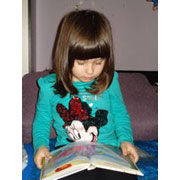 As a mom of a beautiful and intelligent little girl, I was very motivated in teaching her to read. But as you probably know, most children don’t start actually “reading” until around 6 years, and I believe that every child is different and will learn at their own pace. It is very important that we as parents pick up on those cues, but more important is to make learning fun.
As a mom of a beautiful and intelligent little girl, I was very motivated in teaching her to read. But as you probably know, most children don’t start actually “reading” until around 6 years, and I believe that every child is different and will learn at their own pace. It is very important that we as parents pick up on those cues, but more important is to make learning fun.
I don’t want parents to feel pressured that their 3-year-old needs to start reading. The information shared below is general information that is beneficial for children of all ages, whether your child is ready to read or not. Don’t implement all of these strategies at once, nor should you expect your child to be able to do everything right away. It is a process and this information is simply for you to implement when you feel your child is ready.
The reason that children are required to attend school at the age of 5 is because this is the age when children are usually developed enough to begin learning various activities such as reading.
My husband and I have read to our baby whenever she shows interest in it, and she’s moved quickly from enjoying her cardboard-paged books to wanting the novel I’m reading around the house. We have gotten her some magnetic letters and a few of the age-appropriate educational toys from LeapFrog and VTech. We recently also got her the Your Baby Can Read (YBCR) series and DVDs like Baby Einstein or the YBCR, but she really enjoys playing with the flashcards, and while she does, we sound out the word for her so she might start talking more, too. I think any tool that’s available to parents can be useful, as long as the child is interested. There’s no point in trying to teach a child who’s not ready to learn, but there’s no point in outright refusing to teach a child who is ready.
I think that when a child truly learns to read they should be able to understand the content. Most children that read at young ages may have the ability to recognize the words and sometimes associate those words with the correct object for those words; however, they do not have a full understanding of what they are reading.
Studies have shown that if you’re reading and talking a lot to your child, s/he will probably learn to read well before 5 or 6. Kids under a year old can be taught to sign, so they certainly must have the cognitive development to know that symbols can stand for things and ideas. The next step—learning to recognize letters, sounds, and whole words—is just a matter of repetition.
How much you read to your child is completely up to you and your family, but aim to read at least three to four books a day, even while your child is very young. As she gets a little older and can sit for longer stretches of time, make it a family goal to read together for at least 20 minutes each day.
The 10 most important steps (that I implemented with my little daughter):
- Read to your child every day
- Ask your child questions before, during, and after reading
- Make your child realize that you are reading
- Look for letters in the environment around you
- When teaching letters and letter sounds, incorporate as many senses as possible
- Read a variety of books and make a game out of guessing the letters
- Have fun reading
- Work on letter sounds and manipulating them within
- Encourage your child to sound out short words
- Practice memorizing a few sight words each day
- Most of all, have fun together
And please remember that when you teach a child to read you should teach them to enjoy reading as well.

